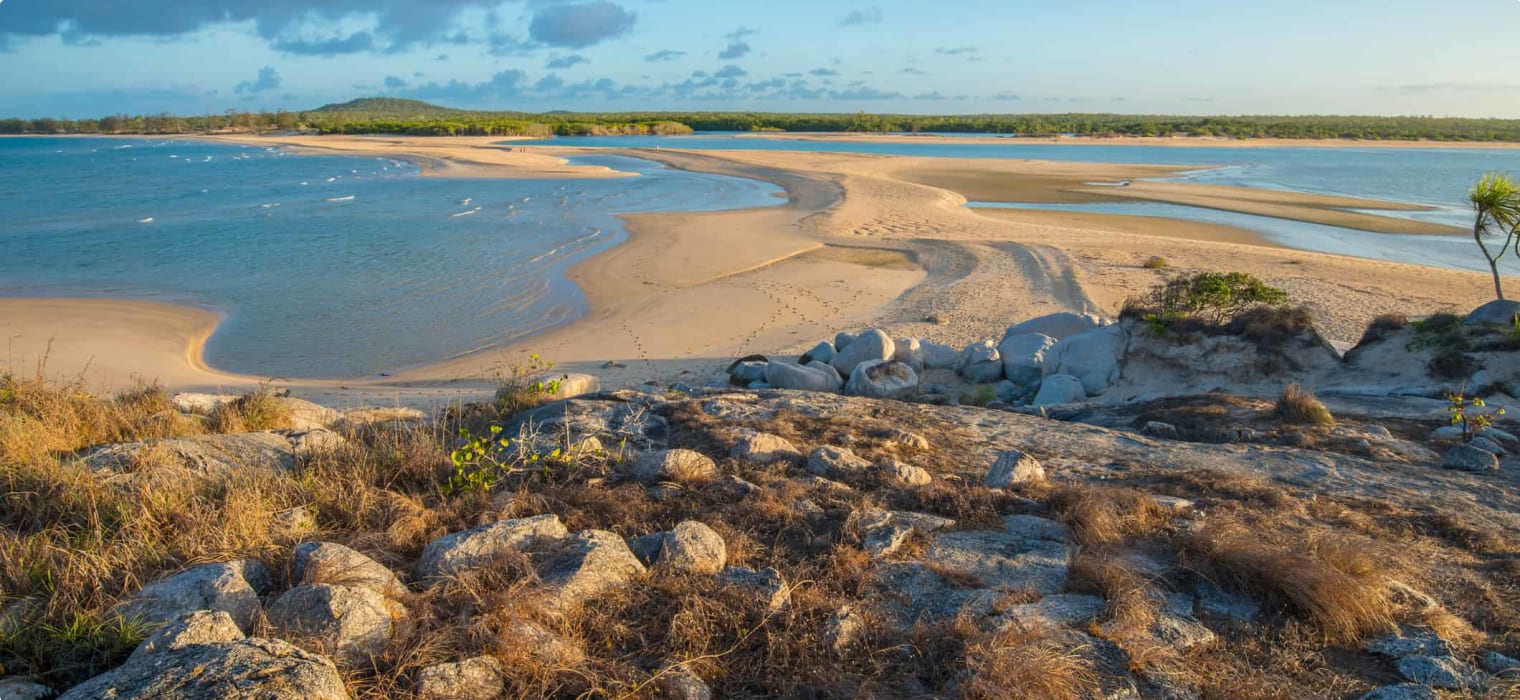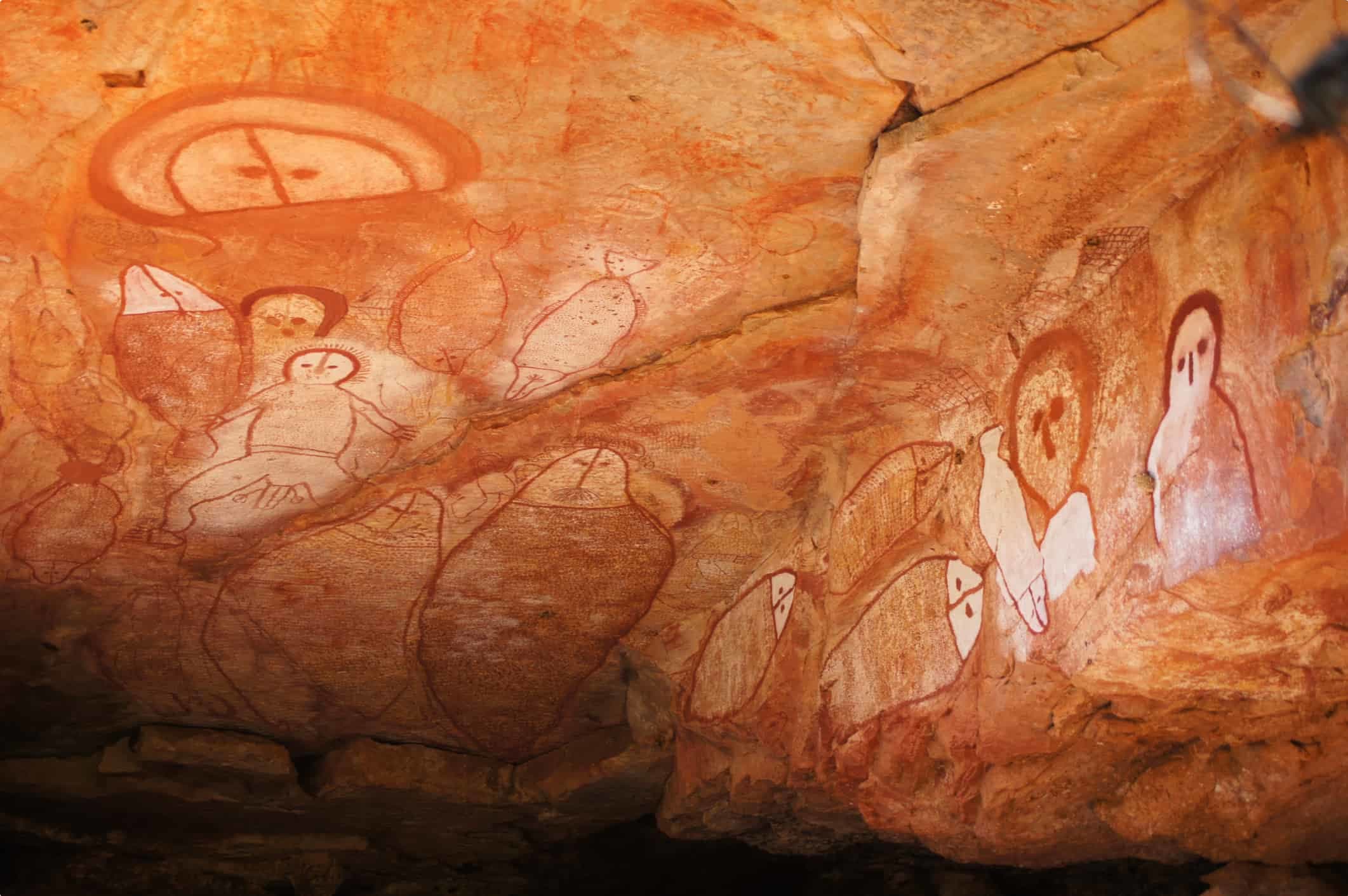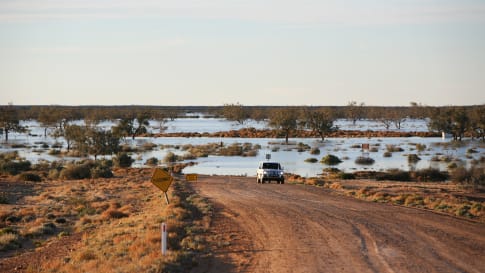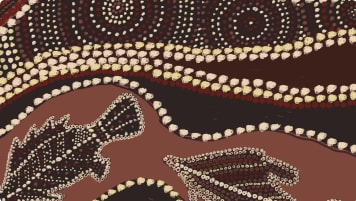Milingimbi Art
Milingimbi art, studied and discussed on a small group tour for mature and senior travellers interested in history and art. Milingimbi is one of a number of different acclaimed art styles of the Aboriginal community history.
14 Dec 20 · 6 mins read

Milingimbi Art
By Marco Stojanovik
Milingimbi Island is the largest of the archipelago cluster known as the Crocodile Islands, lying just a few kilometres off the north-east Arnhem Land coast in the Northern Territory. During the 1950s and ‘60s it burst onto the Australian and international stage as an art centre, renowned for bark painting and other artworks and artefacts produced by the Aboriginal Yolngu people, the traditional owners of the region for over 40,000 years. Despite clan diversity amongst the Yolngu, Millingimbi artists have a distinctive and classic style characteristically combining rarrk, or cross hatching, with iconic abstract motifs and figurative forms.
Traditionally, artworks were transient objects produced for instructional and ceremonial purposes, illustrating cultural mythologies and implementing rites of passage. First collected along with artefacts during the 1920s when the first Methodist missionaries arrived, they soon became a means of artists in the Milingimbi community supporting themselves, originally traded for goods and materials and then later for money as part of a flourishing and successful industry. Today art continues as a strong vehicle for the transferal of culture with stories shared in paintings of bark, fibre works, ceremonial poles and carvings.
This article explores the history and functions of Millingimbi art. Much of the information used is from Cara Pinchbeck, Lindy Allen, and Louise Hamby’s book Art from Milingimbi: Taking memories back.
History
For long Milingimbi had been a meeting place for the trade of valuable items. Annually over hundreds of years, Makassan trepangers from Sulawesi as well as Japanese fisherman visited its shores to live and work with local Yolngu people, collecting and harvesting the abundant sea cucumber delicacy that then made its way to Asia. The impression left by the visitors are still evident today in their language, art, stories, and cuisine.
Yolgnu familiarity with this process of trading informed the choice of Milingimbi as an appropriate site of the establishment of a mission by the Methodist Overseas Mission in 1923. The objective was to deliver evangelism, education, and industry to the Yolngu and to create an economically self-supporting mission. Thus, upon the arrival of missionaries, and subsequently sociologists and anthropologists among others, these systems continued with Yolngu people trading with local goods and handmade objects for commodity items.
Reverend Thomas Theodor ‘Ted’ Webb, who served as superintendent at Millingimbi from 1926-1930, advocated for Aboriginal people to maintain most of their cultural practices. He especially encouraged artists to use their creative skills in the art and craft field as a commercial activity. And so, artefacts and artworks soon began to be traded for goods and materials.
The success of this enterprise quickly became evident with Webb collecting a plethora of bark paintings, weapons, artefacts, utensils, baskets, bags, ceremonial sculptures, and so forth. By 1930 his collection had grown to such an extent he was able to furnish museums and gift individuals. During the first ten years of the mission, 1500 objects were collected and sold to museums.
When the next mission superintendent Reverend Edgar Wells (1949-1959) arrived, he inherited a strong foundation for what would emerge as a flourishing art industry at Milingimbi in the decades to follow. Like his predecessors he valued the preservation of Yolngu customs not deemed contradictory to the missionary way of life. He became fascinated by the art at Milingimbi and actively encouraged people to create bark paintings, wood sculptures, and other art and craft items to sell to the mission.
It was during this time in the 1950s that the Yolngu successfully led a campaign at Milingimbi to be paid wages for their labour, artwork, and other things they sold through the mission stores. Wells agreed noticing that continuing with tobacco, rations and goods “did not encourage the artists fraternity”. In turn, shifting to a cash economy would trigger the emergence of a class of professional artists.
The Gupapuyangu Daygurrgurr clan leader Tom Djawa would play a central role in the acceptance and development of the art movement. He had become leader of the wider Yolngu community during Wells’ early years in Milingimbi and, in response to the interest Wells had shown for the arts, had urged other clan leaders to come to Milingimbi and partake in cultural activities. Artists held a dignified status in Yolngu life and the practice now allowed them to earn an income in a meaningful way and support their families. An outpouring of production thus soon followed.
The practice fulfilled the desire of the missionaries to instill in Yolngu a work ethic that would give them purpose and dignity, and so Wells continued to enthusiastically encourage the artists. With the specific purpose of raising their profile and bringing their work to an ever-growing global audience, he forged key links with people within public cultural institutions, as well as private collectors and art enthusiasts. In doing so the reputation of Milingimbi artists, including Binyinyuwuy, Buranday, Dawidi, Dayngangan, Djawa, Djimbarrdjimbarrwuy, Lipundja, and Makani was able to grow – and by the late 1950s their art had widely captured the attention of Australian collectors.
Within a decade Milingimbi art would also have a strong overseas following. This was largely thanks to lay missionary and teacher Alan Fidock, who arrived in 1961 and was involved in the promotion of the artists’ work to international markets while also running the first arts centre from under his house. During the decade serious collectors and major public galleries and museums would all keenly seek out examples of Milingimbi art, which came to be included in significant exhibitions and publications. Today, works from Milingimbi are found in around 50 key collections worldwide.
A strong core group of artists still live in Milingimbi and its outstations. These artists continue to produce works on bark, carvings, Larrakitj (hollow logs), woven objects including mats, baskets and fish traps, and other smaller craft items such as shell jewelry.
Functions of the Art
It seems clear that Yolngu involvement in producing art and artefacts for Western collections has been motivated in large part by economic considerations. However, the creative endeavours also hold other manifold functions.
Most importantly they enable a representation of who the artists are as people, capturing their cultural identity, while also allowing the expression of the singular vision of each artist. These works are also a tangible celebration of the artists’ home countries and clan affiliations, capturing the dynamism of the country, the unseen forces that have given form to the land and remain as an animating presence. Intimately linked to this is the transmission of knowledge, as intimate details of the landscape are refenced along with a diversity of locations, environmental conditions and the shifting weather patterns of seasonal change. Cultural myths, narratives, and practices are also encoded in the representative images.
Tour of Aboriginal Art & Culture
Odyssey Traveller provides the opportunity to view Aboriginal art on several of our Australian tours. We visit significant sites of Indigenous rock art on our Tour of the Kimberley. This fascinating region of Western Australia – over 400, 000 square kilometres of pristine wilderness spanning Australia’s north west from Broome to Darwin – is home to thousands of ancient rock art sites, believed to be the world’s oldest examples of the art. Set amongst the stunning scenery of the Kimberley – river gorges, boab trees, sandstone formations, waterfalls and pristine beaches – these extraordinary paintings are a testament to an ancient civilisation that remains vital today.
We also learn about the Aboriginal culture and art of Kakadu as part of our new tour of Kakadu and the Northern Territory. The ‘Stone Country’ of Kakadu National Park boasts over 5,000 known Aboriginal rock art sites, with some archaeologists believing that there might be up to 15,000 total sites across the entire park – the greatest known concentration of rock art in the world. Some of the rock paintings are up to 20, 000 years old, constituting one of the longest historical records of any group of people in the world.
Travellers with an interest in learning more about the Aboriginal heritage of Australia may also want to check out our other outback Australia tours, which include visits to Lake Mungo and the Budj Bim Cultural Landscape as part of our new tour of the Southern States of Australia; to the important cultural site of Wilpena Pound on our tour of the Flinders Ranges; and to the Brewarrina Fish Traps in outback Queensland.
Odyssey Traveller has been serving world travellers since 1983. All tours provide an authentic and culturally informed travel experience, that goes beyond the usual tourist sites in favour of drawing out the hidden histories of our destinations. Our guides are chosen for their local expertise, and we move in genuinely small groups: usually 6-12 per tour. Our tours are all-inclusive, encompassing accommodation, attraction entries, and transport. For more information, click here, and head to this page to make a booking.

Articles about Australia published by Odyssey Traveller:
- The Australian Outback: A Definitive Guide
- Uncovering the Ancient History of Aboriginal Australia
- Aboriginal History and Culture of Kakadu National Park
- Aboriginal Land Use in the Mallee
- Understanding Aboriginal Aquaculture
- Aboriginal Art
- Appreciating Australian River Systems
- Charles Sturt and the Search for the Inland Sea
- Camels of the Australian outback
- The Kimberley: A Definitive Guide
For all the articles Odyssey Traveller has published for mature aged and senior travellers, click through on this link.
External articles to assist your visit to Australia:
- The Essential Introduction to Aboriginal Art (25 Facts)
- The Story of Aboriginal Art
- 10 Indigenous Artists You Should Know
- Contemporary Aboriginal Art from the Dreaming
- The Definitive Guide to Modern Aboriginal Art
We acknowledge Aboriginal and Torres Strait Islander peoples as the First Australians and Traditional Custodians of the lands where we live, learn and work. We pay our respects to Elders past, present and emerging.
Related Tours

days
Jun, Jul, Sep, Feb, Mar +1Darwin and Kakadu small group tour
Visiting Northern Territory
Explore and learn as part of a small group tour for seniors on this package tour to Darwin and Kakadu National park, a UNESCO world heritage site. This program also visits Arnhem land. Our focus is on ecology, landscapes and history on this 14 day program in the far north of the Northern Territory.

65 days
MarLong tour of Australia for a small group
Visiting New South Wales, Northern Territory
Small group tour for senior couples and solo travellers touring Australia. Travelling through the outback and visiting many of the famous sights as well as off the beaten track locations. Learn about the history of the people who explored the deserts, from indigenous communities to Europeans, as well as Burke and Wills, visit White Cliffs, Marree and far north Kakadu and the Kimberley.
From A$48,995 AUD
View TourArticles

The Arrival of Aboriginal Australians on the Continent
Tracing Aboriginal history via an outback small group tour for mature and senior couples or solo travellers provides an intriguing learning platform about Australia, rock art, trading and culture that traces a history possibly some 120,000 years ago.

Aboriginal Rock Art in the Kimberley, Australia
The Kimberley is explored on a small group tour for mature and senior travelers, couples or singles. Both Aboriginal community is studied and an appreciation of the wet and dry seasons. This guide on the Kimberley assists the traveler as you start from Broome and travel round via Halls creek and Purnunulu national park over some 17 days in a group of up to 12 people.

Aboriginal Sites of Importance in Outback Queensland, Australia
Outback Queensland is hiding a number of unforgettable indigenous experiences on this small group tour for senior travellers. Especially at the Brewarrina Fish Traps, and Carnarvon Gorge, for example where you can experience and learn about dreamtime creation stories, age-old cultural practices and traditions, and Aboriginal art.

Aboriginal history and culture of Kakadu National Park, Northern Territory
For those seek to learn as they travel then the history of the Aboriginal journey and timelines that unfold as a discovery in Australia seek to fascinate the mature and senior traveller on a small group package tour for couples and singles. From Darwin, this tour also visits Arnhem land as well as Kakadu, during the dry season.

Madjedbebe Archaeological Site, Northern Territory
Madjedbebe Archaeological Site, Northern Territory Near the border of western Arnhem Land and Kakadu National Park in Australia’s ‘top end’, Madjedbebe rock shelter (formerly known as Malakunanja II) is the oldest archaeological site in Australia,…

The Australian Outback: A Definitive Guide
Explore learn and consider what is the outback in this article. For mature and senior travelers considering joining a small group package tours into the outback to see, learn and explore about this unique place, not only the landscape but the Aboriginal approach to living. On each of the tours for couples and the single traveler you learn something different but fascinating, from Outback Queensland, the Flinders, Broken Hill and the Kimberley and the wildflowers all contribute to this question, what is the outback?


